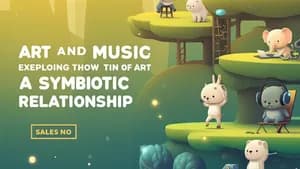Introduction: A Symphony of Creativity
Have you ever noticed how a painting can evoke a specific feeling, a certain melody playing in your mind's ear? Or how a piece of music can transport you to a different place, filling your imagination with vivid colors and shapes? This isn't a coincidence. Throughout history, art and music have engaged in a captivating dance, influencing and inspiring each other in profound ways. This article will explore this fascinating relationship, taking you on a journey through different eras to uncover the remarkable parallels between artistic movements and musical styles. We'll delve into specific examples, providing you with insights and tools to better understand and appreciate the interconnectedness of these two powerful forms of human expression. By understanding these connections, you can deepen your appreciation for both art and music, developing a more holistic understanding of history and culture. I’ve found that making these connections is key to truly grasping the complexities of each individual discipline.
The Renaissance: A Rebirth of Harmony and Form
The Renaissance, a period marked by a renewed interest in classical art and philosophy, witnessed a blossoming of both artistic and musical innovation. Think of the balanced compositions of Renaissance painters like Raphael and Leonardo da Vinci, their works characterized by harmony, symmetry, and a focus on humanism. This same sense of order and structure is reflected in the music of the era, particularly in the works of composers like Josquin des Prez and Giovanni Pierluigi da Palestrina. Their polyphonic compositions, with their intricate interwoven melodies, perfectly mirror the complexity and detail found in Renaissance paintings. To deepen your understanding, try comparing the balanced forms in a painting like Leonardo da Vinci’s ‘The Last Supper’ with the complex harmonies in a Palestrina motet. Note the similar emphasis on structure and the deliberate use of symmetry. This comparative analysis will enrich your understanding of both the artistic and musical expressions of the era.
The Baroque: Drama, Ornamentation, and Emotional Intensity
The Baroque period, spanning roughly the 17th and 18th centuries, was a time of dramatic contrasts and opulent displays. In painting, artists like Caravaggio and Rembrandt used dramatic lighting and intense emotion to create powerful visual narratives. This emotional intensity is perfectly mirrored in the music of the Baroque era, exemplified by composers such as Johann Sebastian Bach and George Frideric Handel. Their works are characterized by grandeur, ornamentation, and a dynamic interplay between contrasting musical ideas. Consider the theatrical lighting in Caravaggio’s paintings and compare it to the dramatic contrasts in a Bach concerto. Notice how both utilize dynamics, light and shade to create emotional impact and visual/auditory drama. Try listening to Bach’s Toccata and Fugue in D minor while visualizing a dramatic Baroque painting. You will immediately grasp the emotional power and energy shared between these art forms.
The Romantic Era: Emotion, Individualism, and Nature's Embrace
Romanticism, a movement that flourished in the late 18th and 19th centuries, emphasized emotion, individualism, and a deep connection with nature. Romantic painters like Caspar David Friedrich and Eugène Delacroix created works that expressed intense feelings and a fascination with the sublime power of the natural world. This same emphasis on emotion and individualism is evident in the music of the Romantic period, exemplified by composers such as Ludwig van Beethoven, Franz Schubert, and Frédéric Chopin. Their music is characterized by passionate melodies, soaring harmonies, and an exploration of a wide range of human emotions. You can explore the parallels by comparing the expressive brushstrokes of a Delacroix painting, such as ‘Liberty Leading the People,’ with the dramatic intensity of Beethoven’s Fifth Symphony. Pay attention to how both use color and dynamic range to communicate powerful emotions. Creating a comparative timeline of key works from both art and music of this era will provide a comprehensive understanding.
The 20th and 21st Centuries: Modernism, Abstraction, and Beyond
The 20th and 21st centuries witnessed a radical shift in both art and music, with the rise of modernism and its many offshoots. Modern art movements like Cubism, Surrealism, and Abstract Expressionism challenged traditional notions of representation and form, exploring new ways of expressing emotion and experience. Similarly, modern music saw a rejection of traditional tonality and harmony, with composers like Igor Stravinsky, Arnold Schoenberg, and John Cage experimenting with atonality, dissonance, and new musical techniques. The fragmentation and abstraction in Picasso’s Cubist paintings find echoes in the atonal compositions of Schoenberg. Similarly, the spontaneous expression of Abstract Expressionist painters like Jackson Pollock resonates with the improvisational nature of free jazz. Experiment with comparing visual elements of a specific artwork to musical elements (rhythm, melody, harmony) in a composition. This cross-disciplinary analysis is an excellent way to appreciate the diversity of artistic expression.
Conclusion: Weaving the Threads Together
Throughout history, art and music have not existed in isolation. They have evolved in tandem, influencing and inspiring each other in countless ways. By exploring their parallel development, you can gain a deeper appreciation for the rich tapestry of human creativity. This comparative approach to learning enhances understanding and allows for more holistic engagement with both art and music. The practical exercises suggested throughout this article will facilitate a deeper understanding of the unique connection between these two creative expressions. By actively engaging with these concepts and examples, you'll uncover a richer understanding of both art and music, and their profound impact on human civilization. Remember, active engagement and careful comparison are key to unlocking the secrets woven into this historical tapestry.

